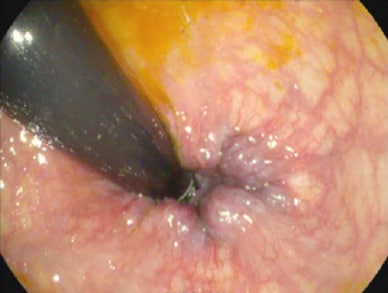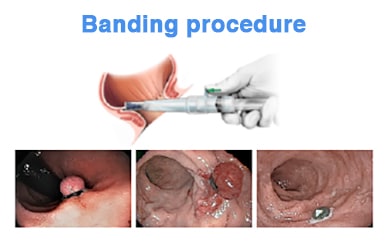May 13, 2016
Hemorrhoids are a normal part of the anatomy of the anorectum. They are vascular cushions that serve to protect the anal sphincter, aid closure of the anal canal during increased abdominal pressure, and provide sensory information that helps differentiate among stool, liquid and gas. Because of their high vascularity and sensitive location, they are also a frequent cause of pathology.
It's estimated that by age 50, about half of adults have had problems with hemorrhoids — the common name for both the structures and the clinical disease. Contributing factors include pregnancy, chronic constipation, diarrhea or prolonged straining, weight lifting, and weakening of supporting tissue as a result of aging or genetics.
Anatomy
Hemorrhoids are classified according to their position relative to the dentate line. External hemorrhoids lie below the dentate line, are covered by squamous epithelium and innervated by cutaneous nerves. If symptomatic, the only definitive therapy is surgical excision.
Retroflexed view of internal hemorrhoids on colonoscopy

Retroflexed view of internal hemorrhoids on colonoscopy
Hemorrhoids are classified as external or internal according to their position relative to the dentate line.
Internal hemorrhoids arise above the dentate line, are covered by columnar cells and have a visceral nerve supply. They are further categorized — and treated — according to their degree of prolapse:
- Grade I hemorrhoids bleed but do not prolapse; on colonoscopy, they are seen as small bulges into the lumen.
- Grade II hemorrhoids prolapse outside the anal canal but reduce spontaneously.
- Grade III hemorrhoids protrude outside the anal canal and usually require manual reduction.
- Grade IV hemorrhoids are irreducible and constantly prolapsed. Acutely thrombosed hemorrhoids and those involving rectal mucosal prolapse are also grade IV.
The most common symptom of internal hemorrhoids is bright red bleeding with bowel movements. Patients may also have pruritus or a sense of pressure, discomfort or incomplete evacuation, sometimes with rectal seepage. Internal hemorrhoids are normally painless — pain often indicates an anal fissure, perianal abscess or thrombosed external hemorrhoid.
Diagnosis
Only about one-third of the roughly 10 million people with hemorrhoids in the United States seek treatment for them.
"It's something most people don't like to talk about, so they suffer in silence. Many patients with hemorrhoids only seek medical care when they're tired of dealing with them," says Sarah B. Umar, M.D., a gastroenterologist at Mayo Clinic's campus in Arizona specializing in anorectal disorders.
She says that although hemorrhoids account for a large percentage of anorectal complaints, it is important to rule out other causes for rectal bleeding and accompanying symptoms — evidence suggests that some patients diagnosed with hemorrhoids have other conditions.
A study published in 2010 in Diseases of the Colon & Rectum prospectively analyzed the diagnostic accuracy of physicians with regard to seven common benign and pathological anorectal conditions: prolapsed internal hemorrhoid, thrombosed external hemorrhoid, abscess, fissure, fistula, condyloma acuminata and full-thickness rectal prolapse. Although diagnosis of all the conditions was poor, physicians were least likely to correctly identify hemorrhoidal disease.
Treatment options
Banding device inserted into distal rectum

Banding device inserted into distal rectum
In rubber band ligation, the banding device is inserted into the distal rectum and the rubber band deployed over hemorrhoidal tissue. The resulting ulcer will eventually scar.
A variety of therapies for hemorrhoids exist, ranging from conservative management and office-based treatments to surgical hemorrhoidectomy. Initial treatment for internal hemorrhoids usually involves dietary and lifestyle modifications.
"Most people try to self-treat with over-the-counter products such as witch hazel and Preparation H, which work temporarily but aren't durable," Dr. Umar says. "For lasting improvements, you must find and fix the underlying problem before treating the hemorrhoids.
"If you ask patients about bowel habits, you invariably find they are spending time reading on the toilet, straining because of severe constipation or suffering from other problems such as dyssynergic defecation. So they may need to treat their bowel habit problems by increasing fiber and fluid intake, taking laxatives or undergoing pelvic floor retraining. You have to try to make those adjustments or patients will have recurring problems."
Of nonsurgical in-office therapies, the most commonly performed procedure is rubber band ligation (RBL), which safely and effectively reduces internal hemorrhoids by applying rubber bands to the base of the hemorrhoidal mass. A meta-analysis of 18 prospective randomized trials published in Diseases of the Colon & Rectum in 2005 found RBL superior to two other conservative medical treatments — sclerotherapy and infrared coagulation — for treating grades I, II and III hemorrhoids.
The goal of RBL is to decrease redundant tissue and cause an inflammatory response that helps attach the prolapsed mucosa back to the underlying muscular layer. Some disagreement exists as to how much tissue should be banded and how many hemorrhoids can safely be treated in a single session. Dr. Umar recommends banding a single hemorrhoidal column per treatment and placing the band 2 to 3 centimeters proximal to the dentate line to minimize pain and the risk of complications. Problems such as bleeding, infection and urine retention occur in less than 1 percent of patients.
"On average, most people need a total of three bands to be placed — sometimes three in one location to eliminate problem tissue and sometimes one band in three different areas," she says. "The whole procedure takes five minutes and requires no bowel prep or sedation. There are no post-procedure restrictions and no recovery to speak of. With proper technique, patients shouldn't have any pain, although some may have a sensation of heaviness for a couple of hours."
She cites a 2005 Cochrane review — updated in 2010 — comparing RBL and surgical removal. Based on three randomized controlled trials, the review found that RBL and surgical excision were equally effective for treating grade I and grade II hemorrhoids but that surgery was better for grade III hemorrhoids. Overall, banding was favored for lack of post-procedure pain and complications, whereas surgical removal had a superior re-treatment rate.
Still, Dr. Umar says banding has just a 13 percent recurrence rate at five years and avoids the potential complications of surgery as well as postoperative pain and recovery time.
"Hemorrhoids aren't always taken seriously by the medical community, but they can cause a great deal of misery and really affect quality of life," she says. "There is even a patron saint of hemorrhoids — Saint Fiacre — a 6th-century Irish monk who is said to have been cured of his hemorrhoids while deep in prayer in the south of France. He reportedly was sitting on a stone and when he arose, the imprint of his buttocks remained. Since then, people have traveled from around the world to obtain hemorrhoid relief by sitting on that stone."
For more information
Grucela A, et al. Prospective analysis of clinician accuracy in the diagnosis of benign anal pathology: Comparison across specialties and years of experience. Diseases of the Colon and Rectum. 2010;53:47.
Cataldo P, et al. Practice parameters for the management of hemorrhoids (revised). Diseases of the Colon and Rectum. 2005;48:189.
Shanmugam V, et al. This review compares the safety and effectiveness of two of the most popular treatments for haemorrhoids, rubber band ligation (RBL) and excisional haemorrhoidectomy (EH). Database of Systematic Reviews.